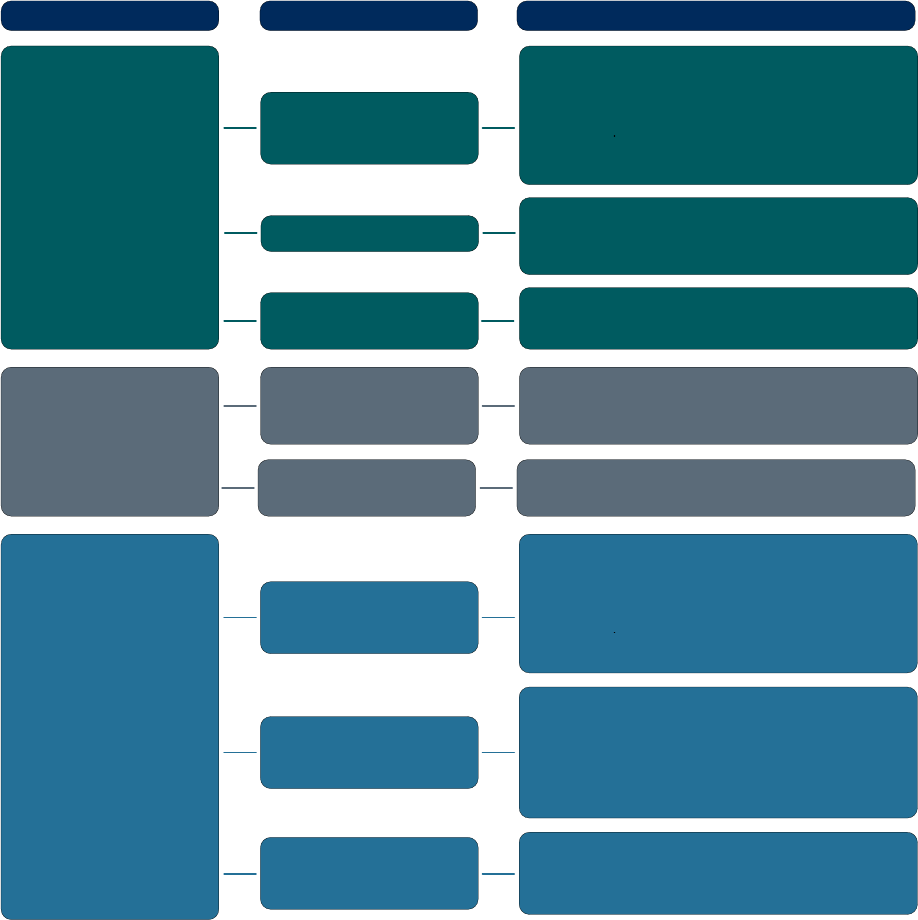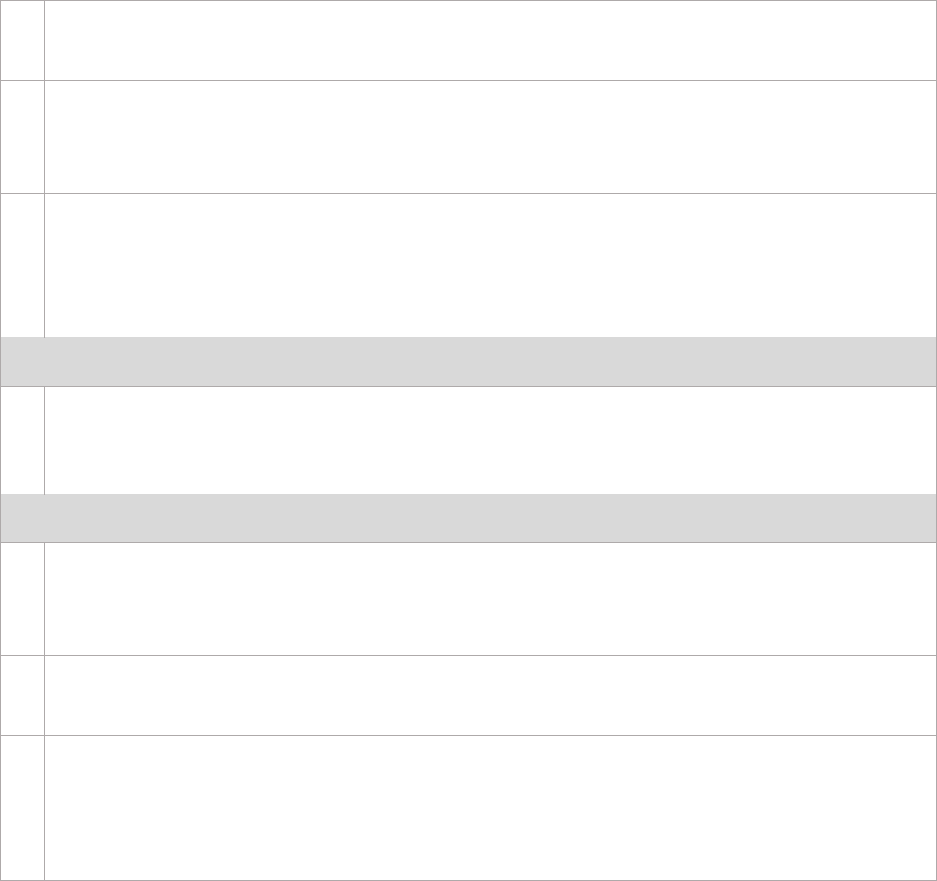
Social Security Administration
Agency Strategic Plan | Fiscal Years 2022–2026
Social Security Administration | March 2022
Social Security Administration | Agency Strategic Plan FYs 2022–2026 Page | 2
Table of Contents
Message from the Acting Commissioner ........................................................................................ 3
Vision .............................................................................................................................................. 5
Mission ............................................................................................................................................ 5
Strategic Framework ....................................................................................................................... 6
Programs ......................................................................................................................................... 7
Organization .................................................................................................................................... 8
Strategic Goal 1: Optimize the Experience of SSA Customers ..................................................... 9
Strategic Objective 1.1 – Identify and Address Barriers to Accessing Services ........................ 9
Strategic Objective 1.2 – Expand Digital Services ................................................................... 11
Strategic Objective 1.3 – Build a Customer-Focused Organization ......................................... 13
Strategic Goal 2: Build an Inclusive, Engaged, and Empowered Workforce .............................. 15
Strategic Objective 2.1 – Promote Diversity, Equity, Inclusion, and Accessibility in Hiring
and Advancement ..................................................................................................................... 15
Strategic Objective 2.2 – Support Employees’ Chosen Career Paths ....................................... 16
Strategic Goal 3: Ensure Stewardship of SSA Programs............................................................. 18
Strategic Objective 3.1 – Improve the Accuracy and Administration of Our Programs .......... 18
Strategic Objective 3.2 – Identify and Eliminate Potential Barriers to Access Contracts and
Grants ........................................................................................................................................ 20
Strategic Objective 3.3 – Improve Organizational Performance and Policy Implementation .. 21
Appendix I: Foundations for Evidence-Based Policymaking Act ............................................... 23
Appendix II: Measuring Our Progress ......................................................................................... 26
Appendix III: Assessing Our Programs ....................................................................................... 27
Appendix IV: Communications and Outreach ............................................................................. 31

Social Security Administration | Agency Strategic Plan FYs 2022–2026 Page | 3
Message from the Acting Commissioner
I am pleased to present the Social Security Administration’s Agency
Strategic Plan for Fiscal Years 2022–2026. This plan communicates our
vision to ensure equity in delivering Social Security services and
improve the accessibility of our services to all. To fulfill that vision, we
will improve access to Social Security services by addressing systemic
barriers to full and equitable participation in our programs through:
1) optimizing the experience of SSA customers; 2) building an inclusive,
engaged, and empowered workforce; and 3) ensuring stewardship of
SSA programs.
For nearly 90 years, we have provided income security for the diverse population we serve.
Over 70 million people receive benefits each year. While our core programs remain unchanged,
we must modernize our service model to best serve our customers.
Through customer engagement, we will strive to understand our customers’ needs, ensure access
to our programs, and deliver customer-focused service. By expanding our digital service options
for individuals who prefer them, we will improve customer experience and service in our local
offices. We are working to better assist those who need in-person support, including customers
with critical situations, complex claims, or limited internet or mobile access.
Over the past several years, we have invested in modernizing our information technology (IT) to
build our customers’ confidence in doing business with us online. Though we have made
progress, changing technology requires continued improvements to provide our customers with
efficient service and to support our employees’ work. We must also address cybersecurity
threats. Our advances in IT, authentication, and security will help ensure we remain focused on
making the right payment to the right person at the right time and protecting our customers’
personal information.
The knowledgeable, dedicated, and talented workforce that administers our complex programs is
essential to our success. We will invest in our employees, as we eliminate barriers to hiring and
advancement to foster an inclusive workforce. We will treat our employees equitably and
provide support for their chosen career paths. We will empower our employees to use their
talents to achieve our strategic goals and continue to make smart decisions about our resources.
We must effectively manage our programs and projects, assess and mitigate risks, and change
course when necessary. As good stewards of our programs, we must continue our quality
reviews, cost-effective program integrity work, and payment accuracy efforts to ensure eligible
individuals receive the benefits to which they are entitled. By expanding the use of data
analytics and predictive modeling and increasing the number and scope of strategic partnerships
with other Federal agencies, we will be better positioned to serve recipients by confirming
eligibility and preventing waste, fraud, and abuse.

Social Security Administration | Agency Strategic Plan FYs 2022–2026 Page | 4
This strategic plan is our vision for how we will evolve as an organization to exceed the service
delivery expectations of our customers in the next five years. We remain committed to
improving our customers’ experience and safeguarding our programs.
Respectfully,
Kilolo Kijakazi
Baltimore, Maryland
March 28, 2022
Social Security Administration | Agency Strategic Plan FYs 2022–2026 Page | 5
Vision
Provide income security for the diverse population we serve.
Mission
Ensure equity and accessibility in delivering Social Security services by improving the customer
experience and addressing systemic barriers to participation in our programs.

Social Security Administration | Agency Strategic Plan FYs 2022–2026 Page | 6
Strategic Framework
Our Strategic Plan for Fiscal Years 2022–2026, with goals that Optimize the Experience of
SSA Customers, Build an Inclusive, Engaged, and Empowered Workforce, and Ensure
Stewardship of SSA Programs and the associated objectives and supporting strategies, provides
the framework for achieving our vision and mission. These goals are informed by strategic
opportunities, our assessment of program evaluations, and our enterprise risk management
(ERM) process, which help us improve the effectiveness of our organization and program
administration. In addition, our FYs 2022–2026 Learning Agenda describes our evidence-
building roadmap to support our strategic goals and objectives. Our 10 priority questions, each
aligned to a specific strategic objective, aim to provide valuable information to promote
evidence-based decision-making and improve operational outcomes.
Optimize the Experience
of SSA Customers
Strategic Goals Strategic Objectives Supporting Strategies
• Identify and address potential inequities in current
policies and programs
• Increase support services for unrepresented claimants
• Conduct implicit bias training for employees
• Conduct and analyze customer satisfaction surveys to
identify areas for improvement
• Better understand our customers’ service preferences
• Address our customers’ service needs
• Increase the use of secure digital services
• Continue modernizing our information technology
• Improve timeliness and eliminate and prevent backlogs
Expand Digital Services
Build an Inclusive,
Engaged, and
Empowered Workforce
Promote Diversity, Equity,
Inclusion, and Accessibility in
Hiring and Advancement
• Conduct analyses to identify and address any systemic
barriers present in hiring and advancement
• Broaden reach for hiring and promote retention
Support Employees’ Chosen
Career Paths
• Invest in our employees
• Ensure inclusive leadership development
Ensure Stewardship of
SSA Programs
• Support our cost-effective program integrity work to
safeguard benefit programs to better serve our recipients
• Enhance our payment accuracy efforts, including
overpayments and underpayments
• Expand the use of data analytics and predictive modeling
• Strengthen our cybersecurity program
• Identify and work to address potential barriers and
bolster open competition in the acquisition and grants
process
• Disseminate acquisition and grant proposal requests
widely to ensure responses from a broad range of
organizations
• Simplify our policies and modernize our processes
• Strengthen program and resource management
• Expand strategic partnerships with external partners
Improve the Accuracy and
Administration of Our
Programs
Improve Organizational
Performance and Policy
Implementation
Identify and Eliminate Potential
Barriers to Access Contracts
and Grants
Build a Customer-Focused
Organization
Identify and Address Barriers
to Accessing Services
Social Security Administration | Agency Strategic Plan FYs 2022–2026 Page | 7
Programs
Few Government agencies touch the lives of as many people as we do. We administer three
programs under the Social Security Act:
• Old-Age and Survivors Insurance (OASI): Established in 1935, the OASI program
provides retirement and survivors benefits to qualified workers and their family members.
In fiscal year (FY) 2022, we estimate we will pay OASI benefits to nearly 57 million
beneficiaries on average each month. We estimate we will pay over $1 trillion to OASI
beneficiaries in FY 2022.
• Disability Insurance (DI): Established in 1956, the DI program provides benefits for
workers who become disabled and for their families. In FY 2022, we estimate we will
pay DI benefits to nearly 10 million beneficiaries on average each month. We estimate
we will pay over $150 billion to DI beneficiaries in FY 2022.
• Supplemental Security Income (SSI): Established in 1972, the SSI program provides
financial support to aged, blind, and disabled adults and children who have limited
income and resources. In FY 2022, we estimate we will pay SSI benefits to nearly
8 million recipients on average each month (approximately 2.7 million of whom
concurrently receive OASI or DI benefits). We estimate we will pay nearly $63 billion in
SSI Federal benefits and State supplementary payments in FY 2022.
In addition, we support national programs administered by other Federal and State agencies, as
required by law, such as Medicare, the State Children’s Health Insurance Program, E-Verify,
Medicaid, the Supplemental Nutrition Assistance Program, and Federal Benefits for Veterans, as
well as programs associated with the Employee Retirement Income Security Act of 1974, the
Coal Industry Retiree Health Benefit Act, and the Help America Vote Act.
Social Security Administration | Agency Strategic Plan FYs 2022–2026 Page | 8
Organization
Nearly 60,000 Federal employees and approximately 15,000 State employees serve the public
from a network of more than 1,500 offices across the country and around the world. Most of our
employees serve the public directly or provide support to employees who do.
We administer our programs and services online, by phone, and in-person in our offices. Our
customers can access services such as applying for retirement, disability, and Medicare benefits;
checking the status of an application or appeal; or requesting a replacement Social Security card.
Our National 800 Number handles over 30 million calls each year. Callers can conduct a variety
of business transactions either by speaking directly with an agent or using our 24-hour automated
services, which include requesting benefit verification letters, ordering replacement Medicare
cards, and obtaining claim status updates.
Our processing centers handle complex Social Security retirement, survivors, and disability
benefit payment decisions, as well as provide support to our National 800 Number. State
agencies make disability determinations for initial claims, reconsiderations, and continuing
disability reviews. Administrative law judges in our hearing offices and administrative appeals
judges in our Appeals Council decide appealed cases.
For more information about our organization and its functions, visit our organizational structure
webpage at www.ssa.gov/org.

Social Security Administration | Agency Strategic Plan FYs 2022–2026 Page | 9
Strategic Goal 1: Optimize the Experience of SSA Customers
Through our OASI, DI, and SSI programs, we provide essential benefits to retirees, survivors,
elderly, or blind and disabled individuals, including those with limited income and resources
who rely on us to meet life’s basic needs. We also support our nation’s workforce who are
paying into Social Security, by providing Social Security numbers, recording wages and
earnings, and maintaining and improving services for workers and their families when they need
to access our programs.
Serving our customers is at the heart of all we do. We listen to our customers and adjust how we
do business to meet their needs. Partially in response to customer feedback, we have offered
more services online, expanded ways to obtain claims status, and changed how employers share
information with us. For example, we piloted an electronic wage filing that simplifies the
process for employers to submit annual wage data. Now, we are strengthening our commitment
to optimizing customer experience through all steps of accessing our programs. Optimizing the
experience of our customers means we provide timely, accurate, and more efficient access to our
services through the delivery channels customers prefer. Doing so requires a better
understanding of our customers’ evolving needs, advancing inclusive policies, and ensuring
equity throughout our programs (e.g., targeted outreach to communities of color and underserved
communities). It also requires that we continue to examine our current policies and procedures
to ensure they are as efficient and equitable as possible.
We are dedicating agency resources to focus on customer experience and transforming the way
we obtain and use customer feedback. We expect our customer experience strategies to result in
continually improving service delivery. These strategies include adopting human-centered
design and standardizing customer experience and satisfaction data collection.
Strategic Objective 1.1 – Identify and Address Barriers to Accessing Services
Lead : Deputy Commissioner for Operations and Deputy Commissioner for Retirement and Disability
Policy
Equity is the bedrock of American democracy, and our
diversity is one of our country's greatest strengths.
Entrenched disparities in our laws and public policies, and in
our public and private institutions, have often failed to serve
individuals and communities equitably. We must identify and
address disparities that underserved communities and
individuals may face in accessing our programs and services.
We are improving our outreach to include diverse
stakeholders and developing relationships with diverse
advocates, civil rights organizations, and community organizations. In addition, answering
Priority Question #1 will provide evidence on the characteristics of people who face barriers in
❶ PRIORITY QUESTION
What are the effects of
changes to our service
delivery methods on the
accessibility, use, efficiency,
security, and equitable
delivery of our services?

Social Security Administration | Agency Strategic Plan FYs 2022–2026 Page | 10
accessing our services and will inform our efforts to deliver
more effective and equitable services. More information
about our efforts to serve all of our customers equitably,
please refer to our Equity Action Plan
(www.ssa.gov/policy/about/racial-equity-resources.html).
We will increase accessibility by streamlining our applications
and dedicating personnel to assist individuals identified as
potentially eligible for our programs. Additionally, we will
ensure unrepresented individuals at disability hearings have
information about their service delivery options, understand
their right to representation, and are prepared to participate in
hearings with administrative law judges. We will use answers
to Priority Question #2 to ensure the disability programs are meeting customer needs.
To support equitable and consistent administration of our programs and services for our
customers, we will provide implicit bias awareness training for our employees and track and
analyze customer satisfaction and complaints.
Strategies:
Identify and address potential inequities in current policies and programs
We will routinely engage in conversations with external stakeholders to discuss service delivery
methods and how we can achieve efficiencies. We will extend our outreach campaigns to
national organizations to reach underserved communities across the country. We will continue
to develop and maintain a network of advocates and community-based organizations and meet
with them regularly to address the needs of people facing barriers.
In addition, we will increase our collection of data by race and ethnicity and employ it to discern
whether there are differences in the rate of participation in our programs or disparities in average
benefit levels. If there are, we will assess the potential factors contributing to these differences
and work to address them.
Increase support services for unrepresented claimants
Our customers have a right to have a representative to help them conduct business with us.
However, nearly 20 percent of claimants at the hearing level do not have representation. We will
support unrepresented claimants at the hearing level during our administrative review process.
Through improved outreach, our goal is to prepare unrepresented individuals to participate in the
hearing process before an administrative law judge. We will also examine our processes and
procedures for potential actions that may result in disparate outcomes for unrepresented
individuals.
❷ PRIORITY QUESTION
To what extent are the
Disability Insurance and
Supplemental Security
Income programs equitably
serving and meeting the
needs, including return-to-
work efforts, of the
population that Congress
intended these programs to
serve?

Social Security Administration | Agency Strategic Plan FYs 2022–2026 Page | 11
Conduct implicit bias training for employees
We established a workgroup on implicit bias and worked with training experts to assess and
develop new training and a proposed curriculum. We will devise and implement agency-wide
policies and trainings to increase equity and equality in our programs. We will use pre- and post-
training evaluations to better understand implicit bias within our organization and the impact of
our trainings to mitigate bias.
Conduct and analyze customer satisfaction surveys to identify areas for improvement
We will analyze data to identify areas for improvement. We will consider the perspectives of
different data sources, such as our ongoing customer satisfaction, prospective client, and
retirement application surveys. We will also review and analyze civil rights complaints
submitted by the public.
Long-term Performance Goals:
• Improve equity in our Supplemental Security Income program through increased outreach
and improved benefit delivery, including to communities of color and underserved
communities.
• Improve equity and benefit delivery in our programs through increased outreach and the
detection of disparities using data collection and analysis.
Strategic Objective 1.2 – Expand Digital Services
Lead : Deputy Commissioner for Operations and Deputy Commissioner for Systems
To optimize customer experience, we must better understand
our customers’ service needs and priorities. We will collect
customer feedback through various touchpoints as they seek
access to our programs, target solutions to address that
feedback, and monitor and improve our processes to meet
customers’ evolving needs.
Because customers increasingly do business with us online
and by phone, we will continue to enhance our digital
services—including online, and self-service options—to allow
customers to complete more transactions with us using their
preferred contact method. The resulting analysis and
assessment from Priority Question #3 will provide additional
evidence and data to prioritize changes that will facilitate the
use of our digital services.
❸ PRIORITY QUESTION
What are the key factors
that influence the public’s
use of our online services,
including the services we
deliver through my Social
Security, and what are the
effects of methods to modify
these key factors on our
customers’ decisions to
create my Social Security
accounts and use our online
services?
Social Security Administration | Agency Strategic Plan FYs 2022–2026 Page | 12
Strategies:
Better understand our customers’ service preferences
To improve the customer experience, we will deepen our understanding of our customers,
including what drives their evolving service preferences. We will learn more about our
customers’ journey through various service channels and touchpoints. We will use Voice of
Customer feedback to understand our customers’ needs and preferences and adjust to improve
their experience. Specifically, an enterprise-wide Voice of Customer feedback will allow us to
capture real-time customer feedback across all service channels, which we will use to identify
customers’ pain points and assess effectiveness of current and new processes.
Address our customers’ service needs
We will implement industry leading customer experience best practices to analyze our
customers’ journeys from start to finish. Through this analysis, we will identify opportunities for
improvement and develop and implement solutions that will improve our customers’
experiences. Solutions will include expanding options that provide a fully digital service
experience for many of our services on a variety of electronic devices and from any location with
internet service. We will also introduce new online options and continue to provide and improve
service through our phone and in-office service channels. For example, customers will be able to
express an intent to file for SSI benefits online and use a mobile-accessible, online process to
upload forms and other documentation.
Increase the use of secure digital services
While we provide the public with additional digital services such as online, remote, and self-
service options that represent the best of current technology, we must do so in a way that
maintains our strong commitment to protect our customers from current and emerging threats
including identity theft and scams to steal money or personal information. The combination of
additional service options and secure access allows our customers to confidently use our digital
services.
Long-term Performance Goals:
• Increase the number of services and forms available on our secure digital platforms to
provide more convenient, user-friendly, and secure digital self-service options.
• Increase the usage of our secure digital services so that customers can conduct business with
us at their convenience.

Social Security Administration | Agency Strategic Plan FYs 2022–2026 Page | 13
Strategic Objective 1.3 – Build a Customer-Focused Organization
Lead : Deputy Commissioner for Operations, Deputy Commissioner for Hearings Operations, and
Deputy Commissioner for Systems
We are aligning our operating model, service delivery
strategy, and information technology (IT) strategy to better
support our customers, including people facing barriers to our
services.
Our IT Modernization Plan, initiated in FY 2018, laid the
groundwork for transforming our legacy systems and
enhancing our service delivery. Building on the plans
described in our IT Modernization Plan, 2020 Update, we will
modernize our infrastructure to keep pace with customer
demands and industry standards. In addition, we will
automate more customer communications including increase
in inventory of notices available online, and expand our use of
emails, texts, and video to respond to customer questions
quickly. We will expand the ability to securely upload forms,
documentation, evidence, and correspondence without the
need for service-specific tools or traveling to a field office.
We will also improve communications with customers and
streamline application processes. The findings in Priority
Questions #4, #5, and #6 will provide us with information to
deliver clearer and more effective communication, improve
our knowledge of how people access information on our
programs, and give us insights into effective ways to
communicate with the public about our disability programs.
Strategies:
Continue modernizing our information technology
We will provide employees with effective, easy-to-use tools
that help them serve our customers more efficiently. We will
continue to improve self-service support tools and video
options, allowing our customers to choose how and when to
conduct transactions and receive immediate access to
available online records, support, and service. Improvements
in our IT will, for example, improve the accuracy and
timeliness of our decisions and enable the public to provide medical evidence and schedule
appointments online.
❺ PRIORITY QUESTION
Does redesigning the Social
Security Statement and
providing supplemental fact
sheets with customized
information on Social
Security’s programs improve
people’s knowledge of the
programs and increase the
use of internet services?
❹ PRIORITY QUESTION
What are the effects of
changes to our
communication methods on
customer satisfaction,
program integrity, and
administrative efficiency?
❻ PRIORITY QUESTION
Does the working-age
population have accurate
knowledge of the Social
Security disability programs,
and to what extent does the
working-age population’s
knowledge, attitudes, and
perceptions of the Social
Security disability programs
influence the decision to
pursue benefits?
Social Security Administration | Agency Strategic Plan FYs 2022–2026 Page | 14
Improve timeliness and eliminate and prevent backlogs
The COVID-19 pandemic disrupted our operations and caused backlogs to grow in several parts
of our organization. The number of initial disability claims pending and the average processing
time for these claims has increased. The COVID-19 pandemic continues to influence
fundamental parts of our initial disability claims process such as the reduced number of medical
providers willing to conduct in-person consultative examinations. We have made it a priority to
improve the average processing time for initial claims generally and work down older cases,
even as our initial claims receipts are projected to increase. Our Agency Priority Goal (APG) on
initial disability claims reflects this commitment.
We will identify opportunities in policies, workloads, and processes for improving and enabling
efficient and effective operations. We will improve claims systems, such as the disability claims
processing system, by increasing our access to electronic medical information to make timely
and policy-compliant disability determinations and improve our customers’ disability application
experience.
While we are striving to eliminate the hearings backlog in FY 2023, we are exploring technology
enhancements, including greater automation and policy and process efficiencies to eliminate and
prevent hearings delays and backlogs. We will explore automation options for other backlogs,
such as initial disability claims and our processing center workloads and improve National 800
Number service performance.
Long-term Performance Goals:
• Improve the customer experience by reducing the Average Speed of Answer on the National
800 Number.
• Improve the customer experience by reducing the average processing time for initial
disability claims and by prioritizing those individuals who have waited the longest for initial
disability determinations.
• Increase our customers’ ability to electronically transact business with the agency to increase
equity and accessibility to our services.

Social Security Administration | Agency Strategic Plan FYs 2022–2026 Page | 15
Strategic Goal 2: Build an Inclusive, Engaged, and Empowered
Workforce
Through their compassion and dedication, our talented employees are the heart of the agency. A
trained, inclusive, engaged, and empowered workforce, with the proper tools to do their jobs, is
critical to our success. However, we are currently challenged by an increasing number of
retirements and staff attrition that is causing a loss of institutional knowledge and complicating
knowledge transfer. Based on staff feedback from employee surveys and exit interviews, we
have learned about potential causes of attrition, which we are working to address. These efforts
include hiring and retaining exceptional people, supporting their chosen career paths, continually
offering them tools to do their jobs, and investing in our employee development and training
programs.
To improve organizational performance and effectiveness, we are aligning our human capital
policies to support in-person and remote customer service delivery. We will use these policies,
as well as existing and emerging technologies, to attract, train, develop, and retain our
workforce.
We celebrate diversity and are committed to creating an inclusive environment for all employees.
We are promoting equity by developing and implementing diversity, inclusion, and cultural
awareness training for all employees. We will ensure our hiring and promotion practices
promote equity as we continue to build a workforce that reflects and delivers customer-focused
service to diverse populations.
Strategic Objective 2.1 – Promote Diversity, Equity, Inclusion, and Accessibility in
Hiring and Advancement
Lead : Deputy Commissioner for Human Resources and Office of Civil Rights and Equal Opportunity
We are committed to promoting diversity, inclusion, fairness,
and equity. The diversity of our workforce is one of our
greatest strengths. Our goal is to attract and retain employees
who reflect the public we serve, are committed to our mission,
and dedicated to providing quality customer experience. We
will promote a workplace that recognizes and celebrates our
employees’ unique abilities and encourages the full
contributions of all. The findings from our evidence-building
activities related to Priority Question #7 in our Learning
Agenda will inform our efforts to achieve this objective.
We will continuously strive to expand applicant pools through
targeted recruitment of underrepresented groups. We will
❼ PRIORITY QUESTION
To what extent are there
systemic barriers to hiring,
developing, and advancing a
diverse and talented
workforce and what are the
effects of our Action Plan to
mitigate those barriers in
support of our goal to build
an inclusive, engaged, and
empowered workforce?
Social Security Administration | Agency Strategic Plan FYs 2022–2026 Page | 16
engage our Advisory Council Chairs within the Diversity and Inclusion Council, who have
connections with the communities they serve and can play a key role to broaden our recruitment
efforts among underrepresented groups. We will also seek talented candidates through
collaborations with universities—such as Historically Black Colleges and Universities (HBCU)
and Minority Serving Institutions (MSI) internship programs, inter-agency partnerships, and
agency-wide developmental programs.
Strategies:
Conduct analyses to identify and address any systemic barriers present in hiring and
advancement
To ensure a workforce that reflects the diversity of our customers at all levels of the
organization, we will conduct analyses to determine if systemic barriers exist and work to
remove any barriers we find. We will implement changes in hiring and career advancement,
particularly around training. We will rethink our workplace culture, as necessary, to further
these commitments.
Broaden reach for hiring and promote retention
Increased workplace flexibility and the increasing use of online services allows us to broaden our
geographic reach for hiring and retention in a way that complements our efforts to promote
diversity and equity in hiring and advancement, where flexibilities are compatible with how we
deliver our mission. Exploring workplace flexibilities, such as remote work when it fits within
mission requirements; create greater interest in Federal employment with us; provide the
opportunity for stability, attractive pay, and benefits packages; and offer opportunities for the
best qualified job candidates regardless of their physical location.
Long-term Performance Goal:
• Increase workforce diversity through improved recruitment, hiring, and retention.
Strategic Objective 2.2 – Support Employees’ Chosen Career Paths
Lead : Deputy Commissioner for Human Resources
We will invest in our employees, increase their engagement, and support their efforts to create
fulfilling careers. We will offer dynamic career paths and opportunities for professional
growth—helping employees become experts and encouraging participation in cross-government
initiatives, such as through leadership development programs.
We will prioritize career growth and leadership development. Our performance management
system will equitably reward high performance and incorporate well-defined and clearly
communicated standards for success. Employees will receive meaningful individualized
feedback on a continual basis to guide their development. Our employee-centered programs will
Social Security Administration | Agency Strategic Plan FYs 2022–2026 Page | 17
foster skills development and facilitate knowledge transfer. We will assess training needs at the
organizational level as well as the individual level, as our programs continually improve. Our
training programs will be dynamic, address critical skill gaps, and will be crafted and adjusted
according to our mission.
Strategies:
Invest in our employees
We will provide agency managers with the tools and resources to enhance their skills and
competencies, optimize organizational performance, address current and future workforce needs,
and attract the talent we need to achieve our business goals. We will modernize our talent
management systems to support interactive and job-specific activities across the employee
lifecycle, further supporting management accountability for improved employee performance
and engagement. We will create opportunities for our employees to design, develop, and
implement strategies to improve service to our customers and performance across the agency.
These measures should boost employee engagement and employee empowerment, which will
improve the employee experience, and lead to improvements in our customer experience.
Ensure inclusive leadership development
One of our greatest challenges is maintaining operations when experienced employees leave the
agency. For example, as of October 1, 2021, approximately 25 percent of our employees were
eligible to retire. To ensure continuity in our public service, we will invest in our future leaders
by developing job-enrichment opportunities to facilitate the transfer of job knowledge from
employees eligible for retirement to retained employees. Employees will have opportunities to
participate in development programs that will broaden their skills and prepare them for
leadership positions.
Long-Term Performance Goals:
• Increase employee engagement and empowerment as measured in the Federal Employee
Viewpoint Survey.
• Expand and maximize leadership development opportunities to promote employee retention
and strengthen succession planning.

Social Security Administration | Agency Strategic Plan FYs 2022–2026 Page | 18
Strategic Goal 3: Ensure Stewardship of SSA Programs
One out of five Americans receives Social Security benefits at any given time and counts on us
to provide accurate information and payments. As good stewards, we continue to look for ways
to do business better, by addressing the root causes of improper payments, improving payment
accuracy (including overpayments and underpayments), bolstering full and open competition in
the acquisition and grants process, and applying sound management principles to everyday work.
We are committed to continually improve the administration of our programs and work to
identify and address potential inequities.
Strategic Objective 3.1 – Improve the Accuracy and Administration of Our
Programs
Lead : Deputy Commissioner for Analytics, Review, and Oversight and Deputy Commissioner for Systems
As good stewards of our programs, we must protect the
privacy of our customers and integrity of our programs, and
prevent fraud, waste, and abuse. We will continue our
effective program integrity work—including medical and
work continuing disability reviews, SSI non-medical
redeterminations, and the cooperative disability investigation
program—which saves billions of program dollars with a
proportionally small investment of adm
inistrative resources.
We will develop, drive, and prioritize business processes,
policies, and automation improvements that ensure
appropriate benefit decisions and target the root causes of
improper payments. Answers to Priority Question #8 will provide a clearer picture of why cases
are remanded and assist in developing recommendations for business process changes. We will
continue to collaborate with our Office of the Inspector General, and support its work to combat
fraud, including Social Security-impersonation schemes, and to educate the public to avoid
scams. These efforts also help to ensure public confidence in our programs and operations.
Data analytics and predictive modeling give us more tools to detect and prevent fraud and
cybersecurity threats. Through our cybersecurity program, we protect the public’s information in
our records, ensure continued payments to millions of beneficiaries, and enable the uninterrupted
availability of our network, systems, and IT resources. We must remain vigilant to potential
cybersecurity threats and ensure a safe and resilient environment.
❽ PRIORITY QUESTION
What factors contribute to
Federal court remands of
disability decisions, and
what are the effects of
modifying relevant factors
on the percentage of final
decisions that are affirmed
upon judicial review?
Social Security Administration | Agency Strategic Plan FYs 2022–2026 Page | 19
Strategies:
Support our cost-effective program integrity work to safeguard benefit programs to better serve
our recipients
Dedicated program integrity funding helps ensure individuals receive the benefits to which they
are entitled, and it safeguards the integrity of benefit programs to better serve recipients by
confirming eligibility, improving payment accuracy for both overpayments and underpayments,
and preventing fraud. In addition, program integrity funding allows us to conduct SSI
redeterminations, conduct the anti-fraud cooperative disability investigations program, and
support special attorneys for fraud prosecutions. We will continue these efforts to ensure public
confidence in our programs and operations.
Enhance our payment accuracy efforts, including overpayments and underpayments
We are committed to mitigating and preventing improper payments by leveraging audit
recommendations, implementing automation and business process improvements, and enhancing
data analytics. We continue to pursue workflow adjustments, policy and notice changes, training
and reminders for technicians, and automation solutions to improve post-entitlement accuracy.
We will increase our outreach to underserved populations, simplify our policies and procedures
to ensure eligible individuals receive the benefits for which they are entitled, automate tools to
alert beneficiaries of overpayments and underpayments, and continue to allow electronic
payments.
Expand the use of data analytics and predictive modeling
We will continue to strengthen and expand the use of large-scale data analytics, complex data
modeling, and related technologies to detect, deter, and prevent fraud, as well as identify
potential additional benefits. We plan to enhance our enterprise fraud risk management program
by introducing more risk assessment activities.
Strengthen our cybersecurity program
We strive to maintain a highly effective cybersecurity program to protect against security threats
and comply with Federal policies and regulations. The continued strength and resilience of our
cybersecurity program is critical to protecting the personally identifiable information we store,
and enabling uninterrupted availability of our network, systems, and IT resources.
Long-term Performance Goal:
• Improve the integrity of the Supplemental Security Income program by reducing
overpayments and underpayments to ensure eligible individuals receive the benefits to which
they are entitled.

Social Security Administration | Agency Strategic Plan FYs 2022–2026 Page | 20
Strategic Objective 3.2 – Identify and Eliminate Potential Barriers to Access
Contracts and Grants
Lead : Deputy Commissioner for Budget, Finance, and Management
Government programs should equitably serve all eligible individuals, and government
contracting and grant opportunities should be equitable for all eligible providers of goods and
services. We will build long-term relationships with academic and professional associations and
develop equity-based guidelines to encourage participation in agency research grant and contract
opportunities by HBCUs and MSIs.
We will also encourage access and participation from Historically Underutilized Business (HUB)
Zones, Woman-Owned, Veteran-Owned, and Small Disadvantaged Businesses by recognizing
and removing hurdles they may face in taking advantage of agency procurement opportunities.
Strategies:
Identify and work to address potential barriers and bolster open competition in the acquisition
and grants process
We will conduct market research in accordance with regulations to bolster full and open
competition in the acquisition and grants process to the maximum extent practicable. We will
devise best practices to encourage participation by institutions serving students of color,
including direct communications with professional associations. We will also develop best
practices to secure contracts with qualified HUBZone, Woman-Owned, Veteran-Owned, and
Small Disadvantaged Businesses.
Disseminate acquisition and grant proposal requests widely to ensure responses from a broad
range of organizations
We will meet with HBCUs and MSIs to learn more about their experience with our grantmaking
process, potential barriers the process presented, and suggestions for eliminating barriers. We
will meet with bidders and recipients of our contracts for HUBZone, Woman-Owned, Veteran-
Owned, and Small Disadvantaged Businesses to learn about their experiences with our
procurement process, barriers they encountered, and recommended solutions to eliminate these
barriers.
Long-term Performance Goal:
• Improve access to contracting and grant opportunities for underrepresented groups and
research institutions serving people of color.

Social Security Administration | Agency Strategic Plan FYs 2022–2026 Page | 21
Strategic Objective 3.3 – Improve Organizational Performance and Policy
Implementation
Lead : Deputy Commissioner for Retirement and Disability Policy and Deputy Commissioner for Budget,
Finance, and Management
We continually improve our program and administrative
policies by updating, simplifying, and advancing policy to
make our programs more responsive, less burdensome, and
easy for our employees to apply consistently. For example,
Priority Question #9 will examine whether potential program
simplification can reduce burden for claimants and
beneficiaries while maintaining program integrity. We will
continue to improve the management of our programs and
projects by implementing quality standards and using proven
project management techniques.
Expanding our ERM program, project management, and data
science capabilities will help us better anticipate and prepare
for challenges in our operating environment. We will use data
analysis to drive smart and accurate business decisions and
mitigate risks. We will continue to create agency spaces that
address our employee and business needs, now and into the
future. Additionally, we are building data-sharing
partnerships to help us better manage our workloads and
resources, obtain evidence-based data to inform policy
decisions, simplify and improve our programs, and ensure the
delivery of our vital services to all communities. For
example, the answers to Priority Question #10 will help us
explore collaborations with other Federal agencies and define
potential projects that remove barriers to accessing needed
services, remove employment barriers, and improve the
administration of our programs.
Strategies:
Simplify our policies and modernize our processes
We will clarify our program rules for both customers and employees. Simplifying our program
rules and policies will help us process benefits for our customers more quickly and make it easier
for customers to complete business with us. We will remove or update outdated provisions and
regularly engage internal and external stakeholders to assess and update policies. For example,
we will continue to make significant progress in updating medical listings to reflect
advancements in the medical industry and emerging research and consider stakeholder input.
❾ PRIORITY QUESTION
What are the effects of
simplifying administrative
rules and requirements on
reducing the burden on
program participants and
supporting program
integrity?
❿ PRIORITY QUESTION
What are the effects of
improving collaboration and
enhancing data sharing with
external agencies on saving
citizens time from reporting
required information,
reducing labor market
barriers, improving program
solvency projections,
improving program
administration, and
reducing improper
payments?
Social Security Administration | Agency Strategic Plan FYs 2022–2026 Page | 22
Strengthen program and resource management
We will use proven program and project management techniques to protect taxpayer dollars and
better serve our customers. We will leverage data, analyses, and program expertise to drive
quicker and more accurate business decisions. We will utilize ERM best practices to manage our
organizational challenges and ensure an enterprise approach in managing risks to deliver our
mission. We will reassess the long-term future of agency facilities and our real property
portfolio, while fulfilling workspace needs, optimizing space utilization, and achieving cost
savings.
Expand strategic partnerships with external partners
We will continue partnering with other Federal agencies to promote our services and
my Social Security through their websites and customer interactions. By taking advantage of
more data exchanges with other Federal and State agencies, we will increase the accuracy of our
records, improve the customer experience, and increase organizational effectiveness.
Long-term Performance Goals:
• Improve customer experience and equity in our disability programs by continuously updating
our medical criteria to reflect advances in medical knowledge.
• Increase our data exchange partners by expanding outreach efforts with the data exchange
community of practice and the States’ data exchange community of interest.

Social Security Administration | Agency Strategic Plan FYs 2022–2026 Page | 23
Appendix I: Foundations for Evidence-Based Policymaking Act
The Foundations for Evidence-Based Policymaking Act of 2018 was signed into law in January
2019. The law incorporates many of the recommendations of the U.S. Commission on
Evidence-Based Policymaking (2017) to improve the use of evidence and data to generate
policies and inform programs in the Federal government.
The law requires the development of a Learning Agenda, an Evaluation Plan, and a Capacity
Assessment of the statistics, evaluation, research, and analysis efforts. The goal is to ensure that
Federal agencies generate evidence of what works in Government and use that information to
improve people’s lives.
Learning Agenda
The Fiscal Years 2022–2026 Learning Agenda (www.ssa.gov/data/) describes our evidence-
building roadmap to support the goals described in this strategic plan. We identified 10 priority
questions that correspond to our strategic plan goals. The priority questions include short-term
and long-term questions related to our mission, strategic planning, and agency operations. We
expect that answers to our priority questions will provide valuable information about our
agency’s performance and promote evidence-based decision-making.
We gathered information from internal and external stakeholders to develop our Learning
Agenda. Our Evaluation Officer established a working group with two representatives from each
of our 11 major offices to obtain their input and identify priority questions.
The working group compiled a list of potential priority questions based on the information
gathered from internal and external stakeholders and completed a process of refining and
prioritizing the questions. After consultating with agency executives, we arrived at 10 priority
questions identified in this Learning Agenda:
# Priority Question
Strategic Goal 1 – Optimize the Experience of SSA Customers
1
What are the effects of changes to our service delivery methods on the accessibility, use,
efficiency, security, and equitable delivery of our services?
2
To what extent are the Disability Insurance and Supplemental Security Income programs
equitably serving and meeting the needs, including return-to-work efforts, of the
population that Congress intended these programs to serve?
3
What are the key factors that influence the public’s use of our online services, including
the services we deliver through my Social Security, and what are the effects of methods
to modify these key factors on our customers’ decisions to create my Social Security
accounts and use our online services?

Social Security Administration | Agency Strategic Plan FYs 2022–2026 Page | 24
4
What are the effects of changes to our communication methods on customer satisfaction,
program integrity, and administrative efficiency?
5
Does redesigning the Social Security Statement and providing supplemental fact sheets
with customized information on Social Security’s programs improve people’s knowledge
of the programs and increase the use of internet services?
6
Does the working-age population have accurate knowledge of the Social Security
disability programs, and to what extent does the working age-population’s knowledge,
attitudes, and perceptions of the Social Security disability programs influence the decision
to pursue benefits?
Strategic Goal 2 – Build an Inclusive, Engaged, and Empowered Workforce
7
To what extent are there systemic barriers to hiring, developing, and advancing a diverse
and talented workforce and what are the effects of our Action Plan to mitigate those
barriers in support of our goal to build an inclusive, engaged, and empowered workforce?
Strategic Goal 3 – Ensure Stewardship of SSA Programs
8
What factors contribute to Federal court remands of disability decisions, and what are the
effects of modifying relevant factors on the percentage of final decisions that are affirmed
upon judicial review?
9
What are the effects of simplifying administrative rules and requirements on reducing the
burden on program participants and supporting program integrity?
10
What are the effects of improving collaboration and enhancing data sharing with external
agencies on saving citizens time from reporting required information, reducing labor
market barriers, improving program solvency projections, improving program
administration, and reducing improper payments?
For each priority question, we provide background information and actions we will take to
answer the question.
Capacity Assessment
Our Capacity Assessment provides a baseline that we will use to measure improvements to the
coverage, quality, methods, effectiveness, and independence of our evaluation, research,
statistics, and data analysis. The Fiscal Years 2022–2026 Capacity Assessment
(www.ssa.gov/data/) includes the following information:
1. A list of the activities and operations of the agency that are currently being evaluated and
analyzed.
2. The extent to which the evaluations, research, and analysis efforts and related activities of
the agency support the needs of various divisions within the agency.
Social Security Administration | Agency Strategic Plan FYs 2022–2026 Page | 25
3. The extent to which the evaluation research and analysis efforts and related activities of the
agency address an appropriate balance between needs related to organizational learning,
ongoing program management, performance management, strategic management,
interagency and private sector coordination, internal and external oversight, and
accountability.
4. The extent to which the agency uses methods and combinations of methods that are
appropriate to agency divisions and the corresponding research questions being addressed,
including an appropriate combination of formative and summative evaluation research and
analysis approaches.
5. The extent to which evaluation and research capacity is present within the agency to include
personnel and agency processes for planning and implementing evaluation activities,
disseminating best practices and findings, and incorporating employee views and feedback.
6. The extent to which the agency has the capacity to assist agency staff and program offices
to develop the capacity to use evaluation research and analysis approaches and data in the
day-to-day operations.
Additional information on both the Learning Agenda and Capacity Assessment is available on
our website at www.ssa.gov/data.
Social Security Administration | Agency Strategic Plan FYs 2022–2026 Page | 26
Appendix II: Measuring Our Progress
We have identified three Agency Priority Goals (APGs) for FYs 2022–2023. These goals are
aggressive and directly support our strategic plan, specifically Strategic Goal 1 (Optimize the
Experience of SSA Customers). To ensure our success in these areas, we conduct quarterly
internal progress reviews and take necessary action to improve our results and reduce costs. As
we approach the FYs 2024–2025 cycle, we will determine the next set of APGs.
1. Improve equity in our Supplemental Security Income program through increased
outreach and improved benefit delivery, including to communities of color and
underserved communities.
• By September 30, 2023, increase the number of all SSI applications by 15 percent,
relative to the 2021 baseline, restoring rates closer to pre-pandemic levels.
• By September 30, 2023, increase the number of SSI applications from underserved
communities by 25 percent, relative to the 2021 baseline.
2. Improve the customer experience by reducing the Average Speed of Answer on the
National 800 Number.
• By September 30, 2023, achieve an average speed of answer of less than 12
minutes, including implementation of estimated wait time and call back options.
3. Improve the customer experience by reducing the average processing time for initial
disability claims and by prioritizing those individuals who have waited the longest for
initial disability determinations.
• By September 30, 2023, achieve an average processing time for initial disability
claims of 164 days.
• By September 30, 2023, decide 85 percent of pending initial disability claims that
begin the fiscal year 180 days old or older.
Other Measurement
We monitor, track, and evaluate progress toward accomplishing our performance goals and
targets on an ongoing basis. The Acting Commissioner and other agency executives review a
monthly performance report, which assesses agency progress in achieving the performance
targets in our Annual Performance Plan and Report (www.ssa.gov/agency/performance). We
develop performance expectations at the beginning of the fiscal year and use them to assess
progress throughout the year. The lead executive responsible for each performance goal
provides a brief explanation for any performance that is behind expectation.
The Government Performance and Results Act, Modernization Act of 2010 (P.L. 111-352)
requires agencies address Federal Cross-Agency Priority Goals in Agency Strategic Plans and
Annual Performance Plans. Please refer to www.performance.gov for information on Federal
Cross-Agency Priority Goals and the agency’s contribution to those goals.

Social Security Administration | Agency Strategic Plan FYs 2022–2026 Page | 27
Appendix III: Assessing Our Programs
We routinely conduct studies and surveys to assess the effectiveness of our programs.
Continuous assessment of the collection of program data, research, and analyses assists us in
identifying strengths and weaknesses in our programs. Information from the program
assessments assist us in developing strategies to address the major challenges we face and
improve the day-to-day administration of our programs. We complete many of our reviews
annually while others may be one-time efforts. The following charts describe some of our
significant assessments and the timeframe for completion.
Assessment Description
Overall Programs Evaluation
Annual Evaluation Plan (Annually)
As required by the Foundations for Evidence-
Based Policymaking Act of 2018, we developed a
FY 2023 Evaluation Plan that describes our
program evaluations to support our FYs 2022–
2026 Agency Strategic Plan or to lay the
foundation for our FYs 2022–2026 Learning
Agenda
Strategic Goal 1 – Optimize the Experience of SSA Customers
Prospective Client Survey (Biennially)
Queries people between ages 50 and 64 to identify
service expectations and preferences of the
upcoming wave of retirees.
Retirement Application Survey (Biennially)
Measures customer satisfaction with the
retirement application process and identifies
service expectations and preferences for future
service among recent retirees.
Evaluation of the Ticket to Work and Other
Employment Support Programs (Continuously)
Examines employment patterns and outcomes of
disabled beneficiaries, including those
beneficiaries who use employment services such
as the Ticket to Work, Partnership Plus, and Work
Incentives Planning and Assistance programs.
We completed an independent 10-year evaluation
of the Ticket to Work (TTW) program in 2013,
which produced seven reports. Since 2013, we
have transitioned to evaluating TTW and other
employment support programs through internal
research, funding collaborative and external
research through our Retirement and Disability
Research Consortium, and other grant programs.

Social Security Administration | Agency Strategic Plan FYs 2022–2026 Page | 28
Strategic Goal 2 – Build an Inclusive, Engaged, and Empowered Workforce
Federal Employee Viewpoint Survey (Annually)
Assesses employee perspectives of organizational
performance across several major human capital
areas: recruitment, development, performance
culture, leadership, job satisfaction, and personal
work experiences.
Human Capital Evaluations (Annually)
Monitors and evaluates how well human capital
policies and programs support our mission
accomplishments. This evaluation is a critical
step in assessing organizational performance and
determining how to improve processes. Our
Human Capital Evaluation System also helps
leadership assess the impact of human capital
strategies designed to achieve agency goals.
Management Directive 715 Report (Annually) Provides the status of our efforts to establish and
maintain effective equal employment affirmation
actions programs under Section 715 of Title VII
of the Civil Rights Act of 1964 and effective
affirmation action programs under Section 501 of
the Rehabilitation Act of 1973.
Strategic Goal 3 – Ensure Stewardship of SSA Programs
Federal Information Security Modernization Act
Report (Annually)
Reports to Congress whether our overall
information technology security and privacy
programs and practices comply with the Federal
Information Security Modernization Act of 2014.
Department of Homeland Security (DHS) Risk
Management Assessment (Quarterly)
Responds to the Office of Management and
Budget (OMB) and DHS-generated DHS Risk
Management Assessment as required by
Executive Order 13800 and outlined in OMB
Memoranda M-17-25 to provide an assessment of
risk for each agency based on information
submitted by agencies for the Federal Information
Security Management Act Chief Information
Officer metrics, which leverage the National
Institute of Standards and Technology
Cybersecurity Framework.
Pre-Effectuation Review of Disability
Determinations (Annually)
Assesses the accuracy of disability determination
services (DDS) initial and reconsideration adult
disability allowances as required in the Social
Security Act.
Safeguard Security Report (Annually)
Provides examples of our policies and procedures
to demonstrate how we safeguard personally

Social Security Administration | Agency Strategic Plan FYs 2022–2026 Page | 29
identifiable information and Federal tax
information. We submit this report to the Internal
Revenue Service (IRS) on an annual basis.
Safeguard Review (Triennially) Evaluates the use of Federal tax information and
the measures we employ to protect this
information. This review is an onsite evaluation
completed in collaboration with the IRS.
Annual Report of the Board of Trustees of the
Federal Old-Age and Survivors Insurance and
Federal Disability Insurance Trust Funds
(Annually)
Reports annually to Congress on the financial and
actuarial status of the two Social Security trust
funds.
Annual Report to Congress on Medical
Continuing Disability Reviews (Annually)
Provides summary information on medical
continuing disability reviews (CDR) conducted
for a completed fiscal year. The report includes
actuarial estimates of the net Federal lifetime
benefit reductions in Old-Age, Survivors, and
Disability Insurance, SSI, Medicare, and Medicaid
benefits resulting from the reviews conducted
during that fiscal year.
Report on Supplemental Security Income (SSI)
Non-medical Redeterminations (Annually)
Provides summary information on non-medical
redeterminations of SSI recipients conducted for a
completed fiscal year.
Bipartisan Budget Act of 2015 Section 845(b)
Report (Annually)
Provides summary information on work-related
CDRs conducted for a completed calendar year.
Annual Report of the SSI Program (Annually) Reports annually to the President and Congress on
the status of the SSI program and provides 25-
year projections of program participation and
costs.
Enumeration Accuracy Report (Triennially) Reports the accuracy of Social Security numbers
assigned during the fiscal year.
Evaluation of the CDR Enforcement Operation
Predictive Model (Annually)
Evaluate the results of a predictive model used to
score work issue CDR cases to ensure that we
prioritize and work cases most likely to result in
overpayments. Our tracking and evaluation each
year indicate the need for improved coordination
with the processing centers in reviewing cases
based on the scores’ priority order.
Targeted Denial Review (Annually) Assesses the accuracy of reconsideration
disability denials made by the DDS.

Social Security Administration | Agency Strategic Plan FYs 2022–2026 Page | 30
Retirement, Survivors, and Disability Insurance
Stewardship Review (Annually)
Measures the accuracy of payments to persons
receiving Social Security retirement, survivors, or
disability benefits by reviewing all non-medical
factors of eligibility and entitlement.
SSI Stewardship Review (Annually) Measures the accuracy of payments to persons
receiving SSI benefits by reviewing all non-
medical factors of eligibility and payment.
SSI Transaction Accuracy Review (Annually) Reviews non-medical aspects of eligibility to
evaluate the adjudicative accuracy of SSI initial
claims, redeterminations, and limited issues to
ensure compliance with operational policy.
Retirement, Survivors, and Disability Insurance
Transaction Accuracy Review (Triennially)
Reviews non-medical factors of eligibility to
evaluate recently processed retirement, survivors,
and disability insurance claims to ensure
compliance with operational policy.
Social Security Administration | Agency Strategic Plan FYs 2022–2026 Page | 31
Appendix IV: Communications and Outreach
In developing this strategic plan, we engaged and consulted with various internal and external
stakeholders regarding our focus areas over the next five years. Our internal management
engagement included discussion with senior leadership and the National Council of Social
Security Management Associations. We engaged our employees through several workgroups,
solicited for input through email, conducted internal briefings and held discussions with our three
unions: American Federation of Government Employees, National Treasury Employees Union,
and International Federation of Professional and Technical Engineers.
For external stakeholder engagement, we held briefings with advocate groups that represent a
wide variety of claimants, including tribal, the under-served, and communities of color. The
advocates provided constructive feedback on how we can better implement our Agency Strategic
Plan. We also briefed the Social Security Advisory Board on our priorities and high-level
framework. We used our work on the agency’s Learning Agenda to seek feedback from the
public. We also had discussions with members of Congress and their staffs.
As we implement this plan, we will continue our outreach to appropriate stakeholders and
engage with both external and internal audiences, particularly our employees. We will continue
to report progress on our activities and collect ideas and feedback to improve our services.
We will also continue to engage the public through Social Security’s blog and website, social
media such as Facebook and Twitter, and our mobile presence. Through these platforms, we will
share information and provide opportunities for collaboration and participation with our
customers.

Social Security Administration | March 2022
Produced and published at U.S. taxpayer expense
